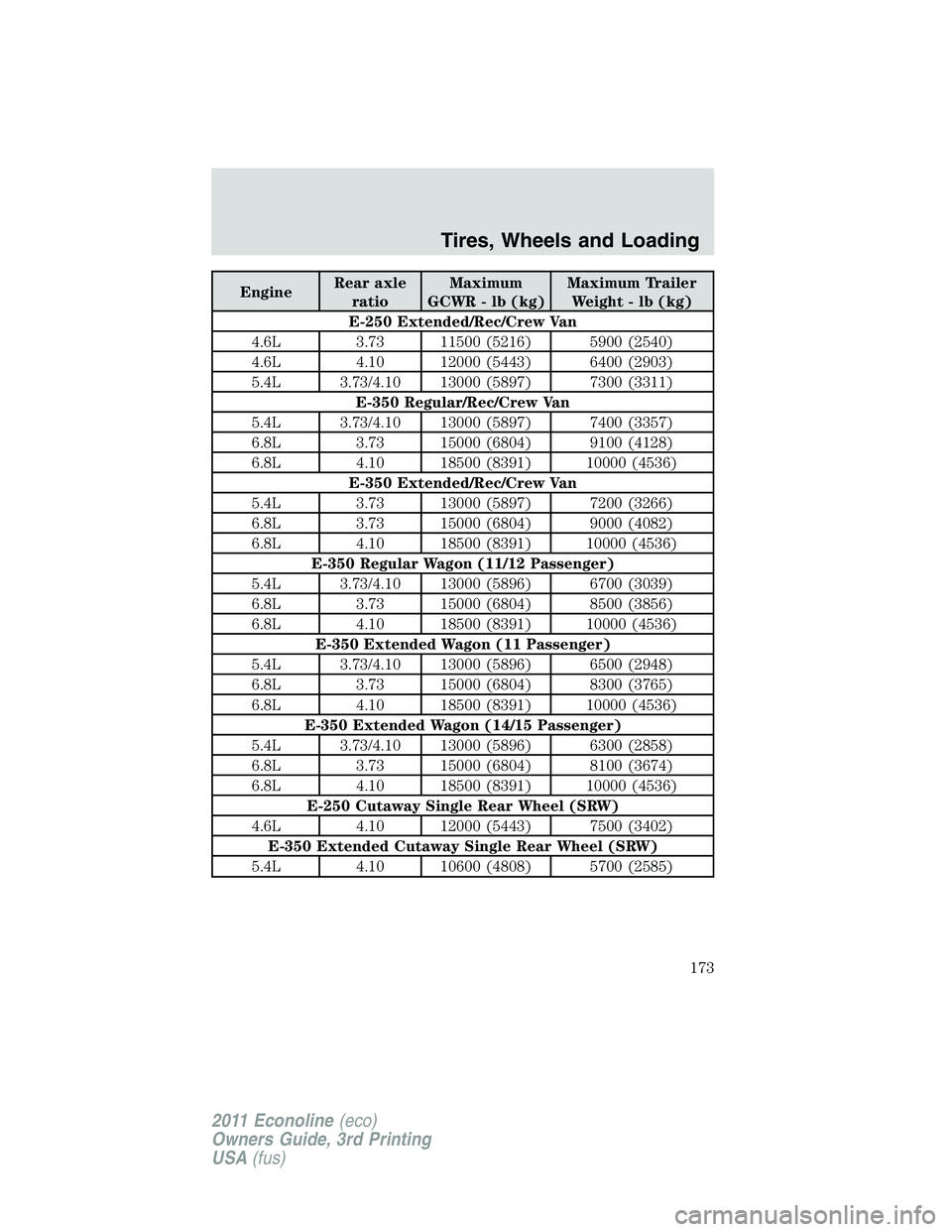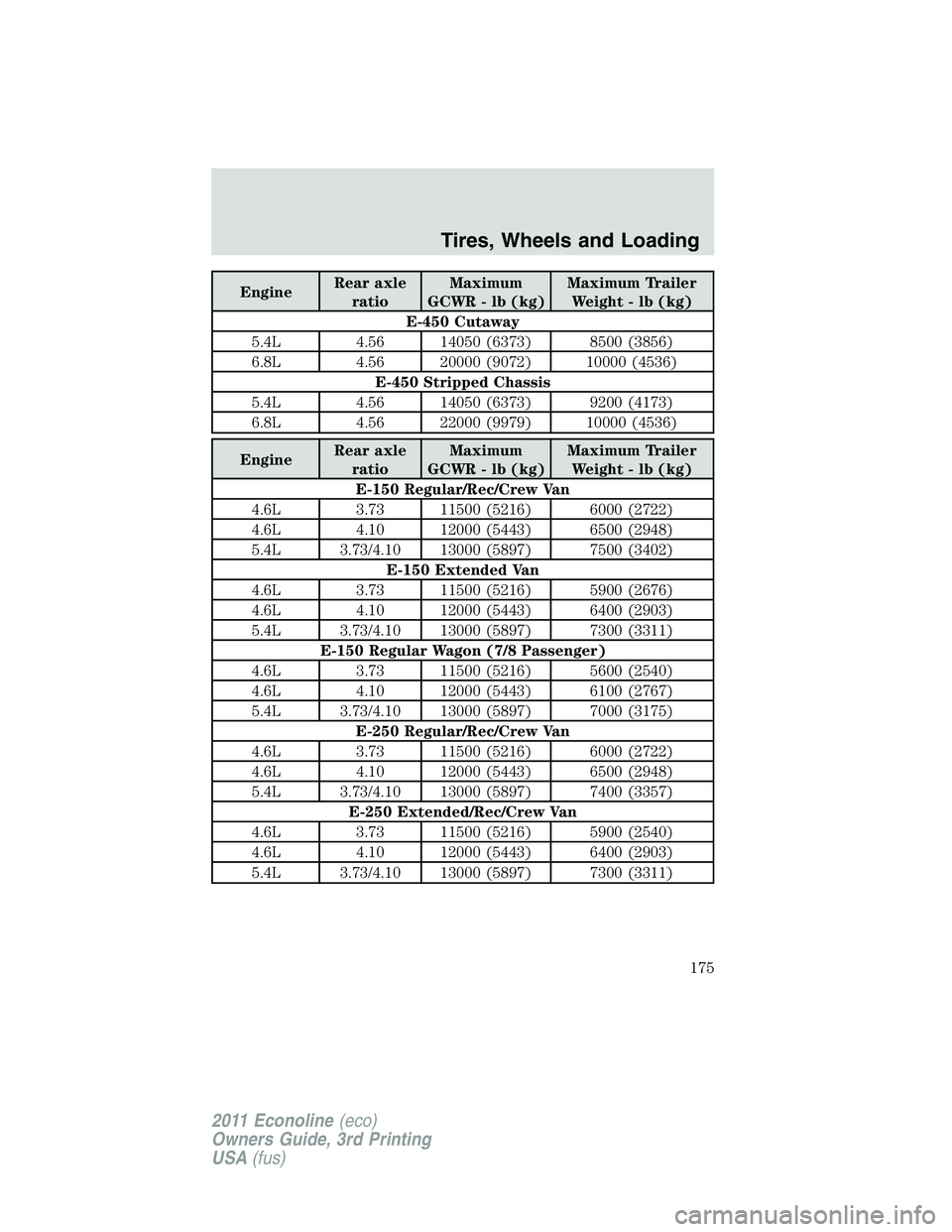2011 FORD E150 wheel
[x] Cancel search: wheelPage 173 of 339

EngineRear axle
ratioMaximum
GCWR - lb (kg)Maximum Trailer
Weight - lb (kg)
E-250 Extended/Rec/Crew Van
4.6L 3.73 11500 (5216) 5900 (2540)
4.6L 4.10 12000 (5443) 6400 (2903)
5.4L 3.73/4.10 13000 (5897) 7300 (3311)
E-350 Regular/Rec/Crew Van
5.4L 3.73/4.10 13000 (5897) 7400 (3357)
6.8L 3.73 15000 (6804) 9100 (4128)
6.8L 4.10 18500 (8391) 10000 (4536)
E-350 Extended/Rec/Crew Van
5.4L 3.73 13000 (5897) 7200 (3266)
6.8L 3.73 15000 (6804) 9000 (4082)
6.8L 4.10 18500 (8391) 10000 (4536)
E-350 Regular Wagon (11/12 Passenger)
5.4L 3.73/4.10 13000 (5896) 6700 (3039)
6.8L 3.73 15000 (6804) 8500 (3856)
6.8L 4.10 18500 (8391) 10000 (4536)
E-350 Extended Wagon (11 Passenger)
5.4L 3.73/4.10 13000 (5896) 6500 (2948)
6.8L 3.73 15000 (6804) 8300 (3765)
6.8L 4.10 18500 (8391) 10000 (4536)
E-350 Extended Wagon (14/15 Passenger)
5.4L 3.73/4.10 13000 (5896) 6300 (2858)
6.8L 3.73 15000 (6804) 8100 (3674)
6.8L 4.10 18500 (8391) 10000 (4536)
E-250 Cutaway Single Rear Wheel (SRW)
4.6L 4.10 12000 (5443) 7500 (3402)
E-350 Extended Cutaway Single Rear Wheel (SRW)
5.4L 4.10 10600 (4808) 5700 (2585)
Tires, Wheels and Loading
173
2011 Econoline(eco)
Owners Guide, 3rd Printing
USA(fus)
Page 174 of 339

EngineRear axle
ratioMaximum
GCWR - lb (kg)Maximum Trailer
Weight - lb (kg)
E-350 Cutaway Single Rear Wheel (SRW) 138” Wheelbase
5.4L 3.73 9600 (4354) 4700 (2132)
5.4L 4.10 13000 (5896) 8000 (3629)
6.8L 4.10 18500 (8391) 10000 (4536)
E-350 Cutaway Dual Rear Wheel (DRW) 138” Wheelbase
5.4L 3.73 10050 (4763) 4900 (2223)
5.4L 4.10 13000 (5897) 7700 (3493)
6.8L 4.10 18500 (8391) 10000 (4536)
E-350 Cutaway Single Rear Wheel (SRW) 158” Wheelbase
5.4L 3.73 9600 (4354) 4600 (2087)
5.4L 4.10 13000 (5896) 8000 (3629)
6.8L 4.10 18500 (8391) 10000 (4536)
E-350 Cutaway Dual Rear Wheel (DRW) 158”/176” Wheelbase
5.4L 3.73 10050 (4763) 4800 (2177)
5.4L 4.10 13000 (5897) 7700 (3493)
6.8L 4.10 18500 (8391) 10000 (4536)
E-350 Stripped Chassis Single Rear Wheel (SRW) 138”
Wheelbase
5.4L 3.73/4.10 13000 (5897) 8700 (3946)
E-350 Stripped Chassis Single Rear Wheel (SRW) 158”
Wheelbase
5.4L 3.73/4.10 13000 (5897) 8600 (3901)
E-350 Stripped Chassis Dual Rear Wheel (DRW) 138” Wheelbase
5.4L 4.10 13000 (5897) 8400 (3810)
6.8L 4.10 18500 (8391) 10000 (4536)
E-350 Stripped Chassis Dual Rear Wheel (DRW) 158”/176”
Wheelbase
5.4L 4.10 13000 (5897) 8300 (3765)
6.8L 4.10 18500 (8391) 10000 (4536)
Tires, Wheels and Loading
174
2011 Econoline(eco)
Owners Guide, 3rd Printing
USA(fus)
Page 175 of 339

EngineRear axle
ratioMaximum
GCWR - lb (kg)Maximum Trailer
Weight - lb (kg)
E-450 Cutaway
5.4L 4.56 14050 (6373) 8500 (3856)
6.8L 4.56 20000 (9072) 10000 (4536)
E-450 Stripped Chassis
5.4L 4.56 14050 (6373) 9200 (4173)
6.8L 4.56 22000 (9979) 10000 (4536)
EngineRear axle
ratioMaximum
GCWR - lb (kg)Maximum Trailer
Weight - lb (kg)
E-150 Regular/Rec/Crew Van
4.6L 3.73 11500 (5216) 6000 (2722)
4.6L 4.10 12000 (5443) 6500 (2948)
5.4L 3.73/4.10 13000 (5897) 7500 (3402)
E-150 Extended Van
4.6L 3.73 11500 (5216) 5900 (2676)
4.6L 4.10 12000 (5443) 6400 (2903)
5.4L 3.73/4.10 13000 (5897) 7300 (3311)
E-150 Regular Wagon (7/8 Passenger)
4.6L 3.73 11500 (5216) 5600 (2540)
4.6L 4.10 12000 (5443) 6100 (2767)
5.4L 3.73/4.10 13000 (5897) 7000 (3175)
E-250 Regular/Rec/Crew Van
4.6L 3.73 11500 (5216) 6000 (2722)
4.6L 4.10 12000 (5443) 6500 (2948)
5.4L 3.73/4.10 13000 (5897) 7400 (3357)
E-250 Extended/Rec/Crew Van
4.6L 3.73 11500 (5216) 5900 (2540)
4.6L 4.10 12000 (5443) 6400 (2903)
5.4L 3.73/4.10 13000 (5897) 7300 (3311)
Tires, Wheels and Loading
175
2011 Econoline(eco)
Owners Guide, 3rd Printing
USA(fus)
Page 176 of 339

EngineRear axle
ratioMaximum
GCWR - lb (kg)Maximum Trailer
Weight - lb (kg)
E-350 Regular/Rec/Crew Van
5.4L 3.73/4.10 13000 (5897) 7400 (3357)
6.8L 3.73 15000 (6804) 9100 (4128)
6.8L 4.10 18500 (8391) 10000 (4536)
E-350 Extended/Rec/Crew Van
5.4L 3.73 13000 (5897) 7200 (3266)
6.8L 3.73 15000 (6804) 9000 (4082)
6.8L 4.10 18500 (8391) 10000 (4536)
E-350 Regular Wagon (11/12 Passenger)
5.4L 3.73/4.10 13000 (5896) 6700 (3039)
6.8L 3.73 15000 (6804) 8500 (3856)
6.8L 4.10 18500 (8391) 10000 (4536)
E-350 Extended Wagon (11 Passenger)
5.4L 3.73/4.10 13000 (5896) 6500 (2948)
6.8L 3.73 15000 (6804) 8300 (3765)
6.8L 4.10 18500 (8391) 10000 (4536)
E-350 Extended Wagon (14/15 Passenger)
5.4L 3.73/4.10 13000 (5896) 6300 (2858)
6.8L 3.73 15000 (6804) 8100 (3674)
6.8L 4.10 18500 (8391) 10000 (4536)
E-250 Cutaway Single Rear Wheel (SRW)
4.6L 4.10 12000 (5443) 7500 (3402)
E-350 Extended Cutaway Single Rear Wheel (SRW)
5.4L 4.10 10600 (4808) 5700 (2585)
E-350 Cutaway Single Rear Wheel (SRW) 138” Wheelbase
5.4L 3.73 9600 (4354) 4700 (2132)
5.4L 4.10 13000 (5896) 8000 (3629)
6.8L 4.10 18500 (8391) 10000 (4536)
Tires, Wheels and Loading
176
2011 Econoline(eco)
Owners Guide, 3rd Printing
USA(fus)
Page 177 of 339

EngineRear axle
ratioMaximum
GCWR - lb (kg)Maximum Trailer
Weight - lb (kg)
E-350 Cutaway Dual Rear Wheel (DRW) 138” Wheelbase
5.4L 3.73 10050 (4763) 4900 (2223)
5.4L 4.10 13000 (5897) 7700 (3493)
6.8L 4.10 18500 (8391) 10000 (4536)
E-350 Cutaway Single Rear Wheel (SRW) 158” Wheelbase
5.4L 3.73 9600 (4354) 4600 (2087)
5.4L 4.10 13000 (5896) 8000 (3629)
6.8L 4.10 18500 (8391) 10000 (4536)
E-350 Cutaway Dual Rear Wheel (DRW) 158”/176” Wheelbase
5.4L 3.73 10050 (4763) 4800 (2177)
5.4L 4.10 13000 (5897) 7700 (3493)
6.8L 4.10 18500 (8391) 10000 (4536)
E-350 Stripped Chassis Single Rear Wheel (SRW) 138”
Wheelbase
5.4L 3.73/4.10 13000 (5897) 8700 (3946)
E-350 Stripped Chassis Single Rear Wheel (SRW) 158”
Wheelbase
5.4L 3.73/4.10 13000 (5897) 8600 (3901)
E-350 Stripped Chassis Dual Rear Wheel (DRW) 138” Wheelbase
5.4L 4.10 13000 (5897) 8400 (3810)
6.8L 4.10 18500 (8391) 10000 (4536)
E-350 Stripped Chassis Dual Rear Wheel (DRW) 158”/176”
Wheelbase
5.4L 4.10 13000 (5897) 8300 (3765)
6.8L 4.10 18500 (8391) 10000 (4536)
E-450 Cutaway
5.4L 4.56 14050 (6373) 8500 (3856)
6.8L 4.56 22000 (9979) 10000 (4536)
E-450 Stripped Chassis
5.4L 4.56 14050 (6373) 9200 (4173)
6.8L 4.56 22000 (9979) 10000 (4536)
Tires, Wheels and Loading
177
2011 Econoline(eco)
Owners Guide, 3rd Printing
USA(fus)
Page 178 of 339

Notes:
•Maximum trailer weight for all cutaway vehicles must be calculated by
subtracting the weight of the vehicle (including incomplete vehicle
weight and payload which includes second unit body weight, cargo
and passengers) from the GCW; otherwise, maximum trailer weight is
10,000 lb (4,536 kg).
•For high altitude operation reduce GCWR by 2% per 1,000 ft (300 m)
elevation.
•To determine the maximum trailer weight designed for your particular
vehicle as equipped, follow the instructions inVehicle loading - with
and without a trailerearlier in this chapter.
Preparing to tow
Use the proper equipment for towing a trailer and make sure it is
properly attached to your vehicle. Contact your authorized dealer or a
reliable trailer dealer as soon as possible if you require assistance.
Hitches
Do not use or install a hitch that clamps onto the vehicle’s bumper or to
the axle. An underbody hitch is acceptable if it is installed properly.
Using a step bumper (if equipped)
The rear bumper is equipped with an integral hitch and only requires a
ball with a one inch (25.4 mm) shank diameter. The bumper has a
5,000 lb (2,270 kg) trailer weight and 500 lb (227 kg) tongue weight
capacity.
If it is necessary to relocate the trailer hitch ball position, a
frame-mounted trailer hitch must be installed.
Safety chains
Always connect the trailer’s safety chains to the frame or hook retainers
of the vehicle hitch. To connect the trailer’s safety chains, cross the
chains under the trailer tongue and allow slack for turning corners.
If you use a rental trailer, follow the instructions that the rental agency
gives to you.
Do not attach safety chains to the bumper.
Tires, Wheels and Loading
178
2011 Econoline(eco)
Owners Guide, 3rd Printing
USA(fus)
Page 179 of 339

Trailer brakes
Electric brakes and manual, automatic or surge-type trailer brakes are
safe if installed properly and adjusted to the manufacturer’s
specifications. The trailer brakes must meet local and Federal
regulations.
WARNING:Do not connect a trailer’s hydraulic brake system
directly to your vehicle’s brake system. Your vehicle may not
have enough braking power and your chances of having a collision
greatly increase.
The braking system of the tow vehicle is rated for operation at the
GVWR not GCWR.
Integrated trailer brake controller (if equipped)
Your vehicle may be equipped with a fully integrated electronic trailer
brake controller (TBC). When used properly, the TBC helps ensure
smooth and effective trailer braking by powering the trailer’s electric
brakes with a proportional output based on the towing vehicle’s brake
pressure.
WARNING:The Ford TBC has only been verified to be
compatible with trailers having electric-actuated drum brakes
(one to four axles) and not hydraulic surge or electric-over-hydraulic
types. It is the responsibility of the customer to ensure that the trailer
brakes are adjusted appropriately, functioning normally and all electric
connections are properly made. Failure to do so may result in loss of
vehicle control, crash or serious injury.
The TBC user interface consists of
the following:
1.+/- (GAIN adjustment
buttons):Pressing these buttons
adjusts the TBC’s power output to
the trailer brakes (in
0.5 increments). The GAIN setting
can be increased to a maximum of
10.0 or decreased to a minimum of 0 (no trailer braking). Pressing and
holding a button raises or lowers the setting continuously. The gain
setting displays in the message center as follows: TBC GAIN = XX.X.
Tires, Wheels and Loading
179
2011 Econoline(eco)
Owners Guide, 3rd Printing
USA(fus)
Page 180 of 339

The trailer brake controller (TBC) is designed to display three items of
information in the instrument cluster message center. These are: gain
setting, output bar graph, and trailer connectivity status. They appear in
the message center as follows:
•TBC GAIN = XX.X NO TRAILER:The instrument cluster message
center displays the current gain setting during a given ignition cycle
and when adjusting the gain. This message is also displayed during
manual activation without a trailer connected or when gain
adjustments are made with no trailer connected.
•TBC GAIN = XX.X OUTPUT = //////:When the vehicle’s brake pedal
is pushed, or when the manual control is activated, bar indicators
illuminate in the instrument cluster message center to indicate the
amount of power going to the trailer brakes relative to the brake pedal
or manual control input. One bar indicates the least amount of output
with six bars indicating maximum output.
•TRAILER CONNECTED:This message is displayed when a correct
trailer wiring connection (a trailer with electric trailer brakes) has
been sensed during a given ignition cycle.
•TRAILER DISCONNECTED:This message is displayed and
accompanied by a single chime, when a trailer connection was
determined and then a disconnection, either intentionally or
unintentionally, has been sensed during a given ignition cycle. It is also
displayed if a truck or trailer wiring fault occurs causing the trailer to
appear disconnected. This message is also displayed during manual
activation without a trailer connected.
2.Manual control lever:Slide the control lever to the left to activate
power to the trailer’s electric brakes independent of the tow vehicle’s
brakes (see the followingProcedure for adjusting GAINsection for
instructions on proper use of this feature). If the manual control is
activated while the brake is also applied, the greater of the two inputs
determines the power sent to the trailer brakes.
•Stop lamps:Activating the TBC manual control lever illuminates both
the trailer brake lamps and the tow vehicle brake lamps except the
center high-mount stop lamp (presuming proper trailer electrical
connection). Pressing the vehicle brake pedal also illuminates both
trailer and vehicle brake lamps.
Tires, Wheels and Loading
180
2011 Econoline(eco)
Owners Guide, 3rd Printing
USA(fus)